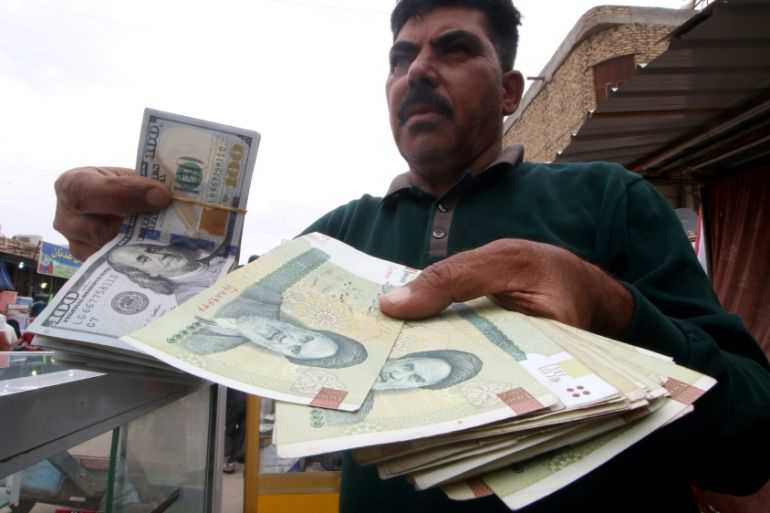Why does Iran have three foreign exchange rates?
Iran’s multi-tiered exchange rate system can at times be confusing even for Iranians.

Iran’s currency, the rial, has suffered a sharp devaluation since United States President Donald Trump decided to unilaterally withdraw from the Iran nuclear deal last year. Inflation and punishing US economic sanctions have effectively cut off Iran from most of the global economy, forcing the government to scramble for foreign currency to pay for humanitarian goods – and leaving ordinary Iranians struggling just to get by.
Intermittent sanctions and financial hardship have been interwoven into the fabric of Iran’s economy since the country’s 1979 revolution, giving rise to a system of multitiered foreign currency exchange rates, which – to be fair – is at times confusing even for Iranians.
Keep reading
list of 4 itemsWhy are nations racing to buy weapons?
Parallel economy: How Russia is defying the West’s boycott
US House approves aid package worth billions for Ukraine, Israel
What are the three existing exchange rates called?
Currently, Iran has three exchange rates; the open market rate, the official rate and the NIMA rate (keep reading if you want to know what NIMA stands for).
What is the open market rate?
This is the exchange rate that most accurately reflects how many rials it takes to buy one US dollar. The most accessible and commonly quoted rate throughout the country, the open market rate more than tripled in the past year and a half. But in the last three months, it’s roughly stabilized, with around 130,000 rials now fetching $1.
What is the NIMA rate?
NIMA is the Persian acronym for an online currency system launched by the Central Bank of the Islamic Republic of Iran (CBI) in April 2018. Put simply, it’s a market where Iranian exporters can sell their foreign currency earnings for Iranian rials. The NIMA exchange rate places a higher value on the rial than the open market rate.
So why would anyone use the NIMA rate if it’s a worse deal than the open market?
Exporters use it because they have to. NIMA was established to make sure the CBI has enough foreign currency to pay for imports of food, medicine and other humanitarian goods even when the Iranian rial rapidly depreciates.
The NIMA rate has gradually risen since its inception to get closer to the open market rate and now hovers around 110,000 rials to $1.
Anything else I need to know about NIMA?
NIMA deals only in hawala, an Islamic system for moving money to distant locations – usually across borders – that operates outside the formal banking system (which is helpful when the majority of the country’s banks have been cut off from the global financial system because of US sanctions).
In a hawala transfer, dealers operate in a network built on trust. It’s less expensive than moving money through the formal banking system, and globally, it’s very popular with migrant workers who want to send remittances home.
Got it. So what is the “official” exchange rate in Iran?
The official exchange rate is 42,000 rials to $1. It is a government subsidised rate that values the rial far, far above the open market rate. Currently, the official rate is only used to import essential goods, but that wasn’t always the case.
What used to be the case?
In response to an escalating currency crisis in April 2018, the administration of Iranian President Hassan Rouhani artificially “unified” the open market rate with the official exchange rate and declared that using all other rates outside that unified rate was tantamount to smuggling.
And how did that work out?
Not so well. The artificial unified rate quickly unraveled and the government was forced to recognise other foreign exchange rates at play in the Iranian economy.
So why have an “official” subsidised exchange rate at all?
To protect Iranian consumers. Remember, the official rate is used to buy essential humanitarian imports that are exempt from US sanctions. If the purchase of those goods weren’t subsidised through the official exchange rate, the end purchasers of those essential products could see sudden, dramatic price jumps and be unable to afford those goods.
Is there a chance more exchange rates will emerge?
If the modern history of the Iranian economy is any indication, yes. In fact, the CBI is expected to soon launch a “regulated foreign exchange market” that – at least at first – will deal in macro cash deals to “discover true rates”.
That may create a fourth rate in the short term, although it may also nudge the country towards true rate unification.
Does the Rouhani government favor multiple rates?
By no means, according to Rouhani. Rate unification was in fact one of his campaign promises and the administration was steadily bridging the gap between the official and the open market rates before US sanctions hit.
Officials have since said that multiple exchange rates are an unfortunate necessity while US sanctions ravage the Iranian economy and, by extension, the financial lives of ordinary Iranians.
Is Rouhani the first to give rate unification a try?
No, he isn’t. Iran was battling 12 different exchange rates after the eight-year Iran-Iraq War in the 1980s.
Every administration since then has tried its hand at rate unification, but ultimately failed. That’s because most administrations tried to artificially fix the rate of the rial as the Rouhani administration did last year.
What have multiple rates done to the Iranian economy?
There is a consensus that the economy should move towards true rate unification in the long run since multiple rates beget corruption and enable rent-seeking activities (taking more out of the economy than one puts in).
The multi-layered currency regime and failed endeavors to make it go away have also played a role in continuously devaluing the Iranian rial over the years.